As far as wargaming rulesets go, Bolt Action is not a particularly difficult one to pick up and learn. With only two editions, it has not seen the regular parade of new editions, re-writes, and meta shifts that Games Workshop customers are subjected to. However, at this point Bolt Action 2nd Edition has over 30 supplements, spanning thousands of pages of material with hundreds of units available to wargamers.
Understandably, in this panoply of rules, scenarios, unit entries, and theatre selectors, there are some things that fall through the cracks. This article is dedicated to the rules of Bolt Action that are regularly forgotten, overlooked, and ignored; the rules so annoying or maligned that invoking them draws an eye-roll and a sigh; and the rules no one seems to ever use correctly.
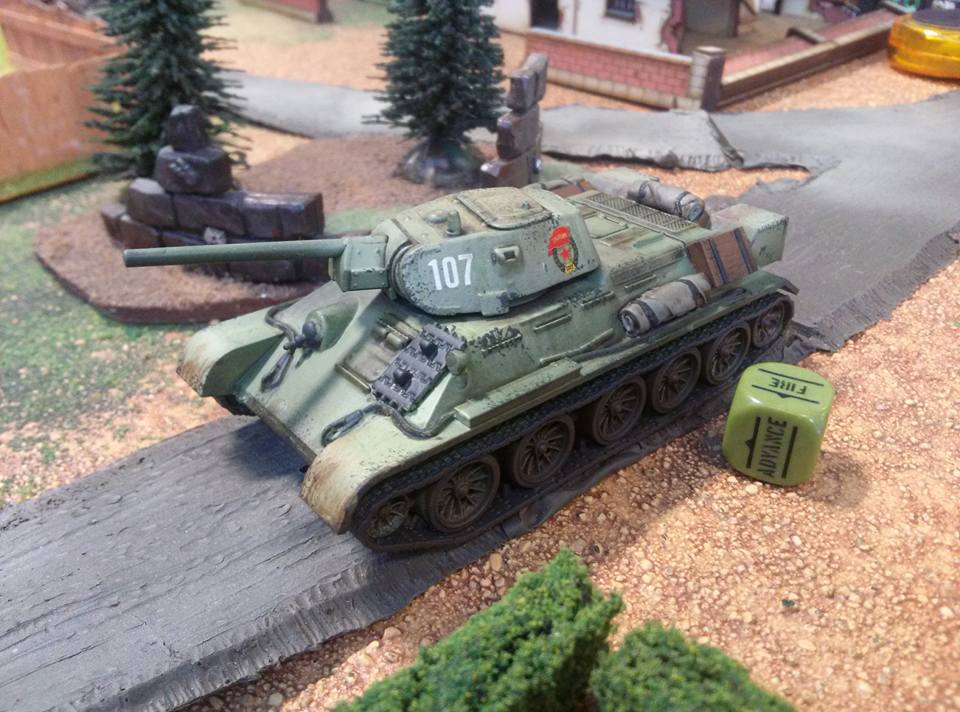
*Disclaimer: Although I consider myself fairly well-versed in Bolt Action please bear in mind that these are just my opinions and understanding of the rules, and of course it’s just as possible that I’ve also forgotten, overlooked, or misinterpreted rules here!
The Forgotten
With a page count now rivaling the collected works of J.R.R. Tolkien, it’s understandable that there are some obscure rules in Bolt Action that everyone seems to forget about. Several of the entries here were added in the 2nd edition, that veteran players may have glossed over. Perhaps you’ll find some hidden gem of a rule in this section that will bail you out of a sticky situation in your next battle. Onwards!
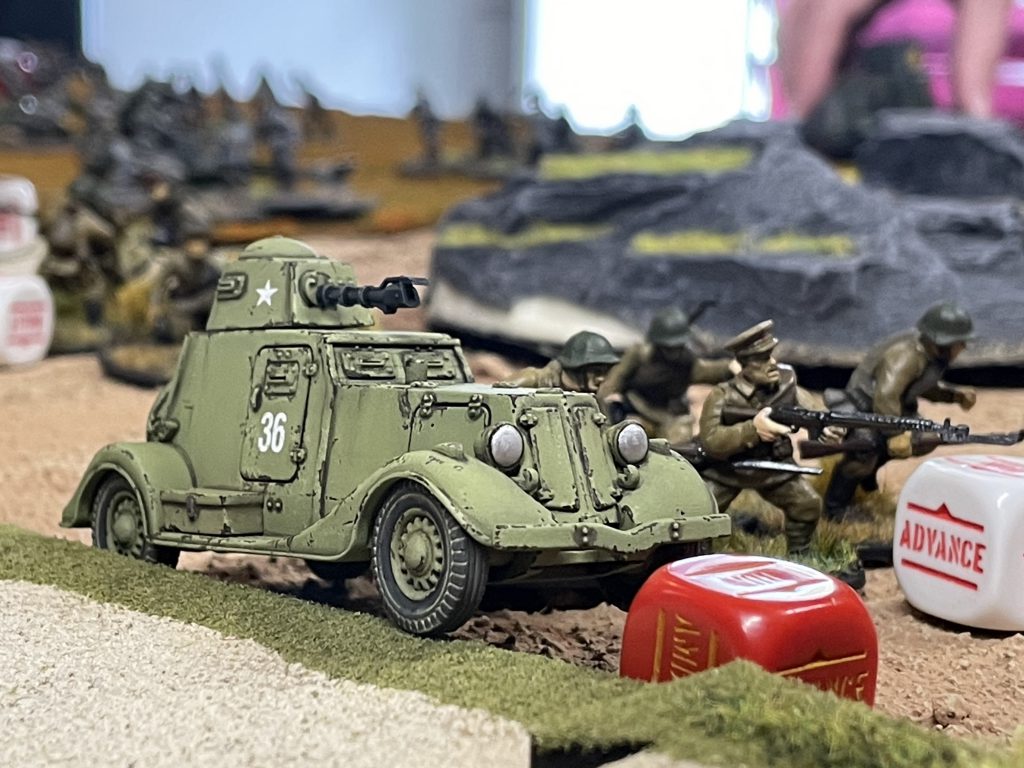
At Full Strength
This easily missed rule on page 41 of the Order Test section of the rulebook gives a small bonus to infantry units of ten or more men who are at the maximum allowable size for their unit. So long as they remain At Full Strength, they can reroll failed Order Tests.
This is a fairly fleeting bonus, since as soon as you take a casualty the bonus is lost. Really, the only applicable situation that comes to mind is if your fresh squad is shot at and takes a pin, but no casualties. Still, better than nothing!
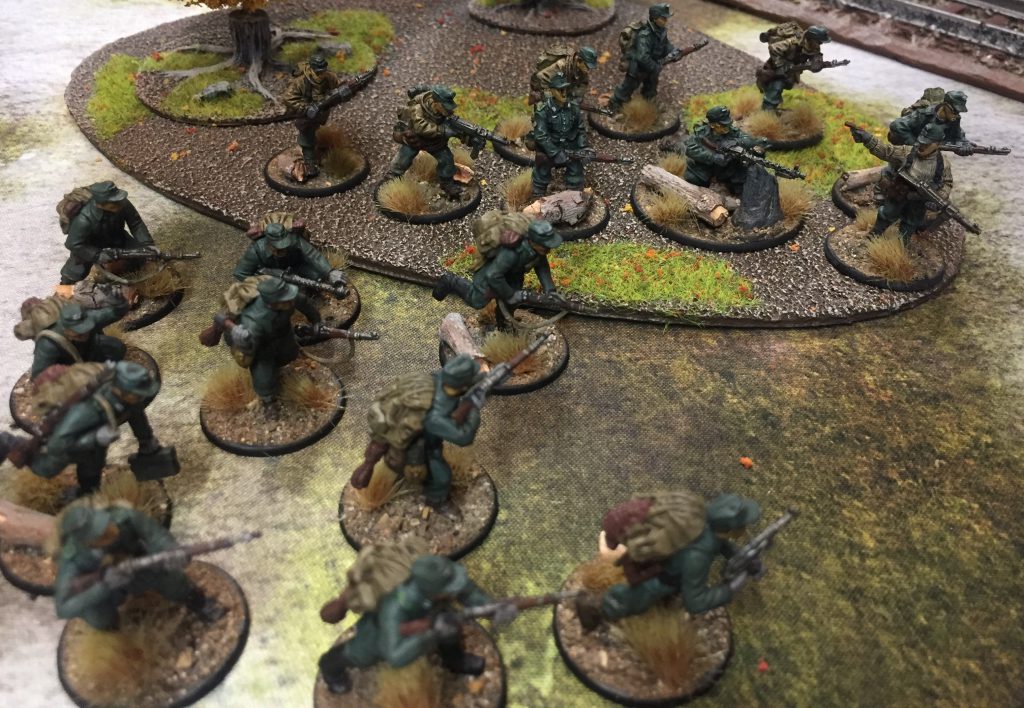
Retaining Orders
Page 43 of the rulebook contains another frequently forgotten ability. In this case, it’s not that the existence of the rule is forgotten, but instead that players frequently forget to invoke in the heat of battle! Of course, I’m talking about retaining orders at the end of the turn.
In Bolt Action, units that are Down or in Ambush can decide to retain their order dice instead of returning them to the dice bag. There are a couple reasons why you might want to do this: in the case of Ambush, it allows a unit set to Ambush to continue on overwatch, so that you don’t need to spend a dice pull putting them back onto Ambush next turn if you want them covering a section of the battlefield. Very useful for weapons like AT guns that you want to use to keep an enemy vehicle penned in.
For Down orders, units will remain safely in the dirt, and a little-known bonus is that units that remain Down at the end of turn automatically lose D3 pins. This can be a good choice for units that went Down to avoid fire but have taken some pins. Instead of standing up to Rally, and possibly getting shot all over again, they can remain safely down and unpin themselves.
Penetration Dropoff
While Bolt Action players are quite familiar with the -1 penalty to hit when at long range, a frequently overlooked side effect of long range is that it also reduces weapon’s penetration bonus as well! That’s right, heavy weapons have -1 penetration at long range, unless they have a special rule that says otherwise (such as rocket propelled munitions like bazookas and Panzershreks/fausts).
This can have important implications for the survival of your armored vehicles, so consider tattooing it on your body, ala Memento, so you don’t forget!
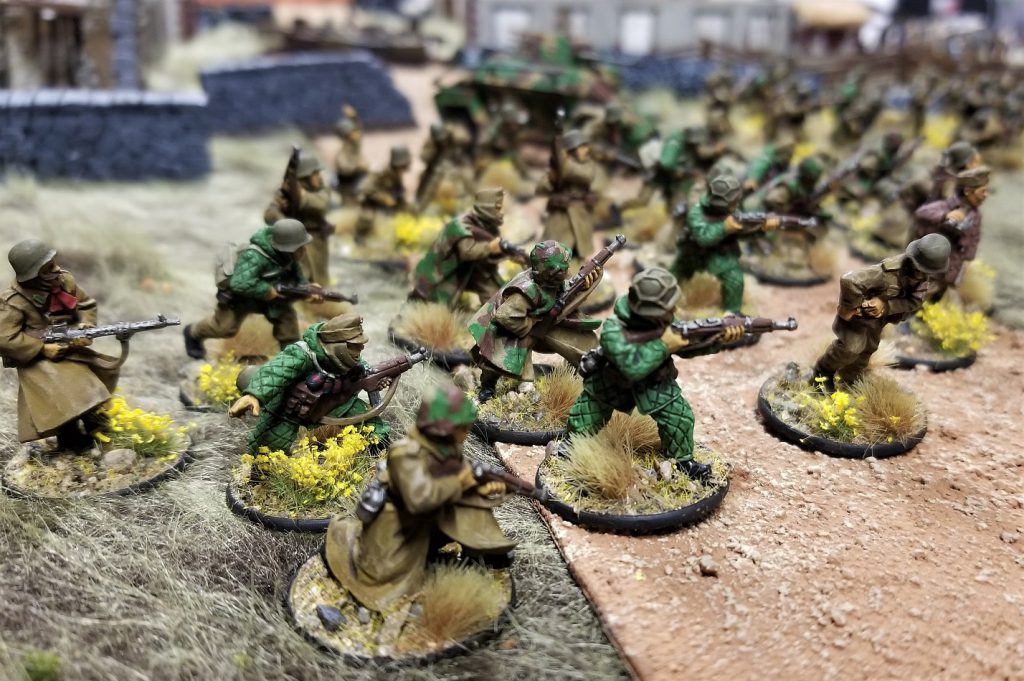
Splitting transports
Brought too many bros to battle and not enough room in the transport? No problem, you can split units across transports! The stipulation is that all the transports need to be of the same type (jeep, universal carrier, etc) and remain within 3” of each other. This is most commonly used with universal carriers.
This rule is kind of unwieldy to actually use, but it’s useful to know if you play armies that can field lots of little transports, like the British and US.
Vehicles failing order tests
Down orders on vehicles generally don’t do anything, as the vehicle can’t very well get any closer to the earth. Instead it just sits there inertly. However, when a vehicle fails an Order Test due to pins, instead of staying put, it will sometimes reverse away from danger! (Page 101)
This will only happen when a vehicle has a visible enemy in their front arc. They will then reverse away as far as possible and gain a Down order. This can sometimes be a blessing, and sometimes a curse! Getting a little distance, especially from marauding panzerfaust enthusiasts can be great, but sometimes you don’t want to leave the position you’ve taken up!
The Misunderstood
This section is dedicated to the rules that BA players frequently struggle to get right. Either because of common misconceptions, confusing syntax in the writing, or the sheer bizarreness of the rule. I’ll do my best here to set the record straight so you can bust out a nice “um, actually” for your next Bolt Action match.

Snipers
Let’s start with snipers. Despite being a very common selection in BA lists, there is definitely some confusion about what they are capable of. In particular, the fact that they always inflict Exceptional Damage when they cause a casualty has some implications that aren’t clear if one only reads the sniper entry on page 91.
To understand the knock on effects, we need to visit the section on Exceptional Damage on page 58 which clarifies that when weapon teams (such as a bazooka, or medium machine gun) suffer Exceptional Damage, the weapon itself and its operator are destroyed and removed from play.
Then, we need to visit the rules for Support Team Weapons on page 73, which explains that when the model carrying the team weapon is killed, the entire team is removed from play. So, to put it all together, a sniper who successfully damages a weapon team may elect to kill the weapon operator, which in turn destroys the entire unit. This applies for the following team types: machine gun teams, mortar teams, sniper teams, flamethrower teams, and anti-tank teams.
This doesn’t apply to squad-based teams (such as LMGs) or artillery teams, in which just a single model is removed. Yes, it is hard to understand how exactly a sniper could 360 no-scope a heavy mortar team out of existence, but them’s the rules baby.
High Explosive vs. Armor Piercing
Something that many players overlook is that different ammo types are in the game, but are mentioned only briefly and quite easy to overlook. On page 68 the rulebook explains that some weapons can choose between armor piercing and high explosive shells. This means that the player needs to choose to either use the penetration value listed in the unit entry OR the high explosive entry in the weapon’s special rules.
So, for example, a heavy autocannon could fire two shots with +3 penetration (armor piercing) or two high-explosive shots which would use the 1” template each and have +1 penetration. A lot of people consulting the weapon chart may be inclined to apply both the penetration value and the HE effects of their shells, but this is double-dipping! Basically, if a weapon has both a penetration value and HE in the special rules, you need to announce which type of shell you’re firing before you roll.
Spotters
When is a unit not a unit? When it’s a spotter! One of Bolt Action’s odd foibles are spotter models, which break many of the established rules on what is or isn’t a unit.
The easiest way to explain spotters is this: they are in all respects a separate unit from their mortar/artillery piece with the exception that they share an Order Dice. Basically either the spotter or mortar can be given an order, but not both. So if you Run your spotter somewhere, the mortar essentially can’t be given an order that turn.
Spotters also have some unique mechanics in that they can’t assault or fire at enemy units, and always count as Down when they’re not moving. Honestly, forward observers should just be their own full unit with the ability to spot for all indirect weapons on the field, but maybe that’s something that can be addressed in the next edition.
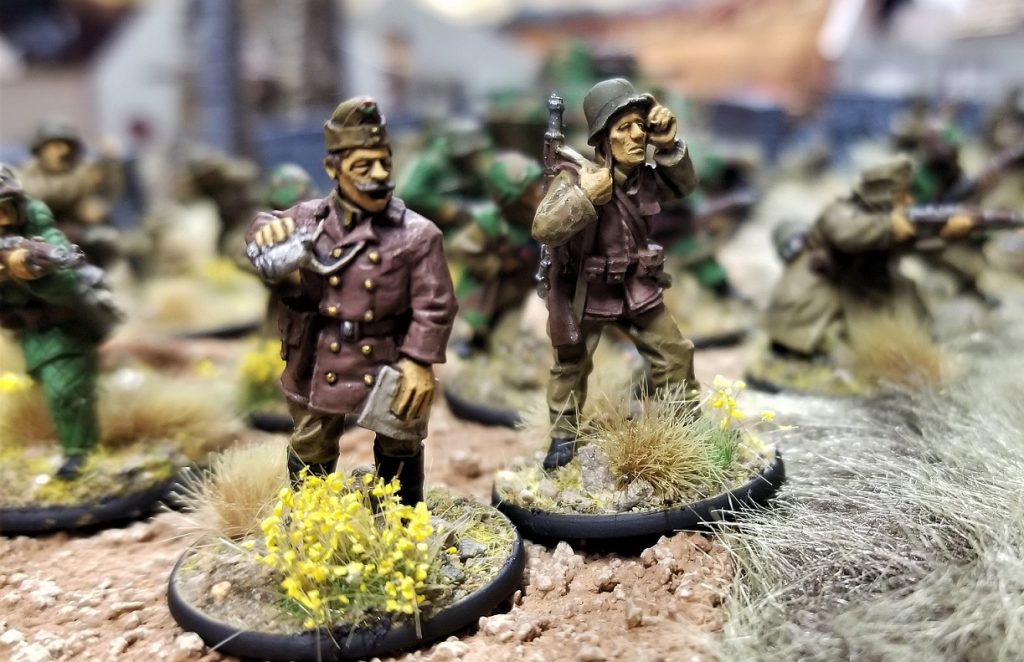
Shooting from/at buildings
BA’s shooting rules are usually pretty straight forward, but when units enter buildings, things can get a little wonky.
Many players treat buildings as basically just hard cover with a roof, but buildings have lots of little specific rules that are easy to miss. For example, when shooting out of a building, you have to fire from an opening (such as a window, door, or hole), and only two models can fire out of any given spot. So if a house has two windows on one side, only four models would be able to fire in that direction.
However, while in a building, you can actually split the fire of your squad and each face of the building can fire at different targets, which in theory would allow you to put pins on multiple targets. If you deploy inside a building at the start of the game you can also make a loophole in the side of the building to create a new/additional opening to fire out of. These two abilities are, in my experience, almost always overlooked and not taken advantage of.
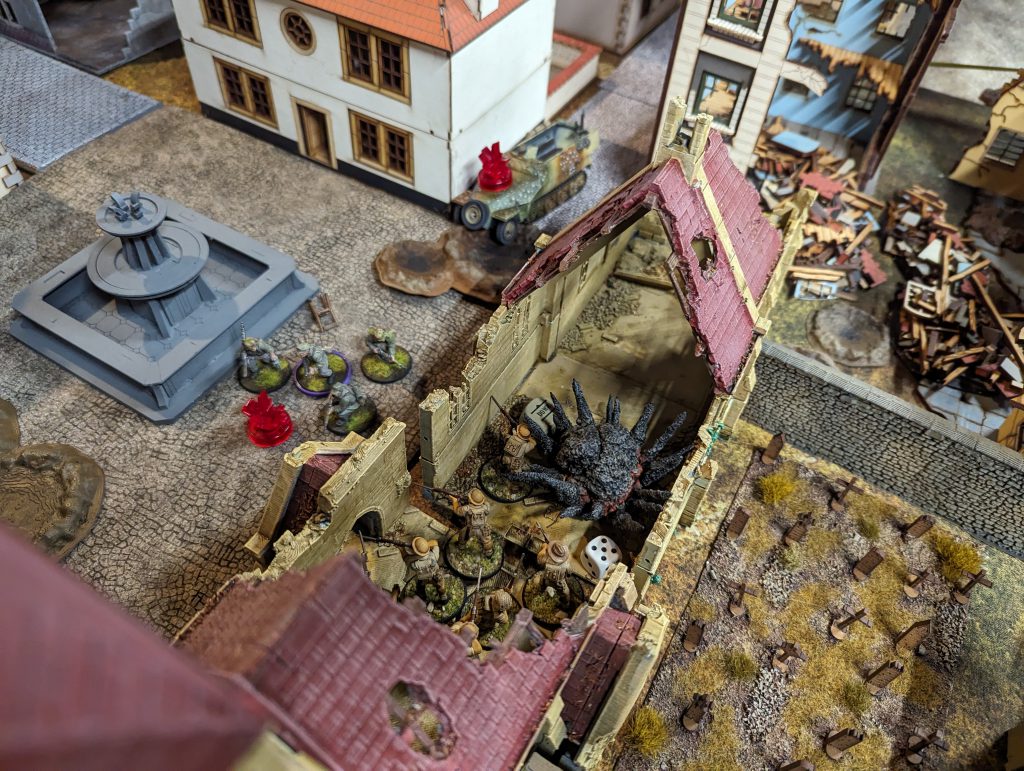
Meanwhile, in order to shoot small arms at units in buildings, the firing unit needs to have line-of-sight on an opening on the floor the enemy unit is occupying – they can’t, for instance, fire into a solid brick wall and hit the enemy that way. Even if the enemy is able to fire through an opening, the defending unit in the building gets both hard cover and the benefit of the Extra Protection rule, effectively +1 to the die roll needed to damage them. As you can imagine, this makes shooting enemies out of buildings quite difficult.
The solution to this is heavy weaponry, which ignore the opening requirement, since they can fire straight through walls. Even better are high explosive weapons or flamethrowers which furthermore ignore the cover bonus of the building, and the Extra Protection rule.
A final step that many players miss after firing HE or flamethrowers at a building is to determine the fate of the building itself. Buildings that suffer 10 or more hits from HE collapse, killing everyone inside, while flamethrowers have a 50% chance of setting the building on fire, forcing everyone inside to evacuate.
One extra foible of buildings is that even empty buildings can be targeted by HE weapons, allowing players to preemptively destroy them, or hope that the blast catches nearby enemy units as well. This is particularly effective with multiple launchers, like Nebelwerfers and Katyushas. Since buildings are easy to draw line-of-sight to, you can target an empty building, then measure the 6” in every direction from the footprint of the building, dramatically increasing the range of the bombardment.
This is a pretty cheesy tactic, but is explicitly allowed in the FAQ – just be warned that it won’t make you many friends.

Recce
Cavalry and some armored cars have the Recce rule, which is one of the most powerful rules a unit can have in Bolt Action, but it can be quite confusing because there are several different abilities it confers.
First, Recce vehicles can reverse at their full Advance rate, rather than at half speed, as well as making its normal amount of pivots, as if it were driving forward. Recce vehicles can also spot hidden units at longer distances.
However, the real gem of recce is the “Escape Move”. This allows them to react to being attacked by trying to break line-of-sight, or get further away from the unit targeting them. Essentially, a unit with Recce that has not already acted that turn can pull their order dice and make an Advance or Run order to escape the enemy attack.
The FAQ clarifies that you should first try to break line-of-sight by moving behind cover, even if it means moving closer to an enemy. Failing that, you can move further away, perhaps gaining partial concealment or putting a long range modifier on the enemy’s shot.
This can allow units with Recce to essentially force an enemy to waste their Fire or Assault action if it can no longer see or reach the Recce unit.
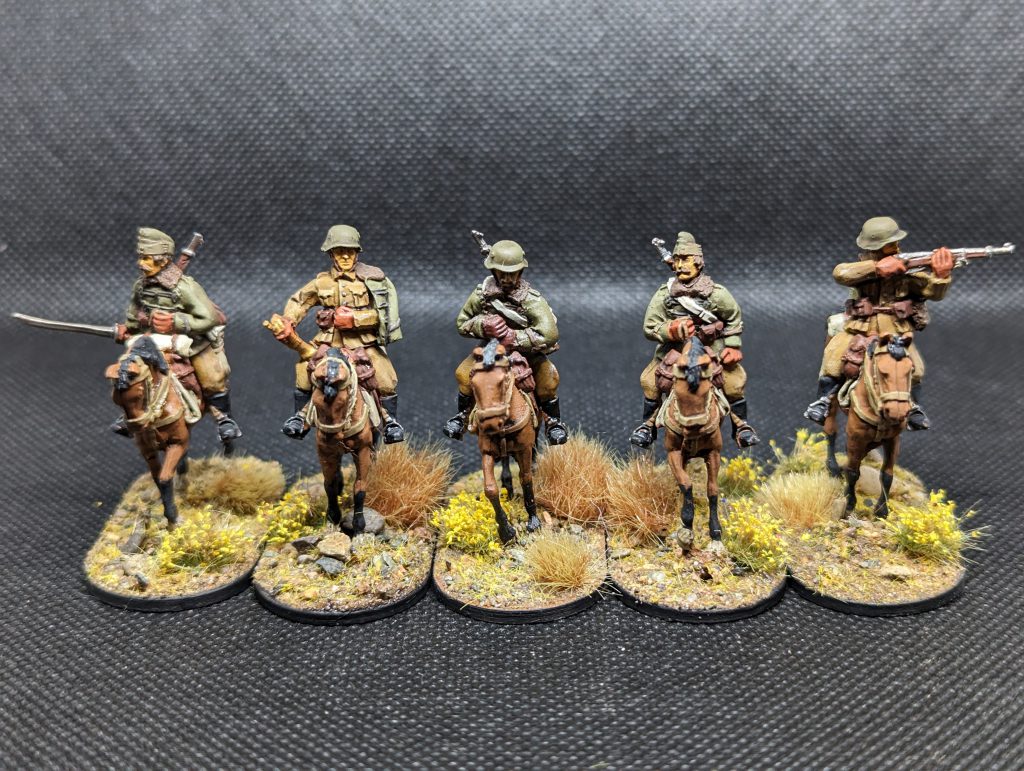
Infantry assaulting tanks
Historically, tanks were extremely vulnerable to enemy infantry at close range. The lack of situational awareness from inside the tank could allow enemy infantry to run right up to the tank and disable it with grenades or other devices.
In Bolt Action, however, assaulting tanks with infantry is not particularly effective – namely because of the bespoke system that is used for handling this type of assault. Essentially, infantry that want to assault a tank have to pass several extra steps before they can even dream of damaging an enemy tank.
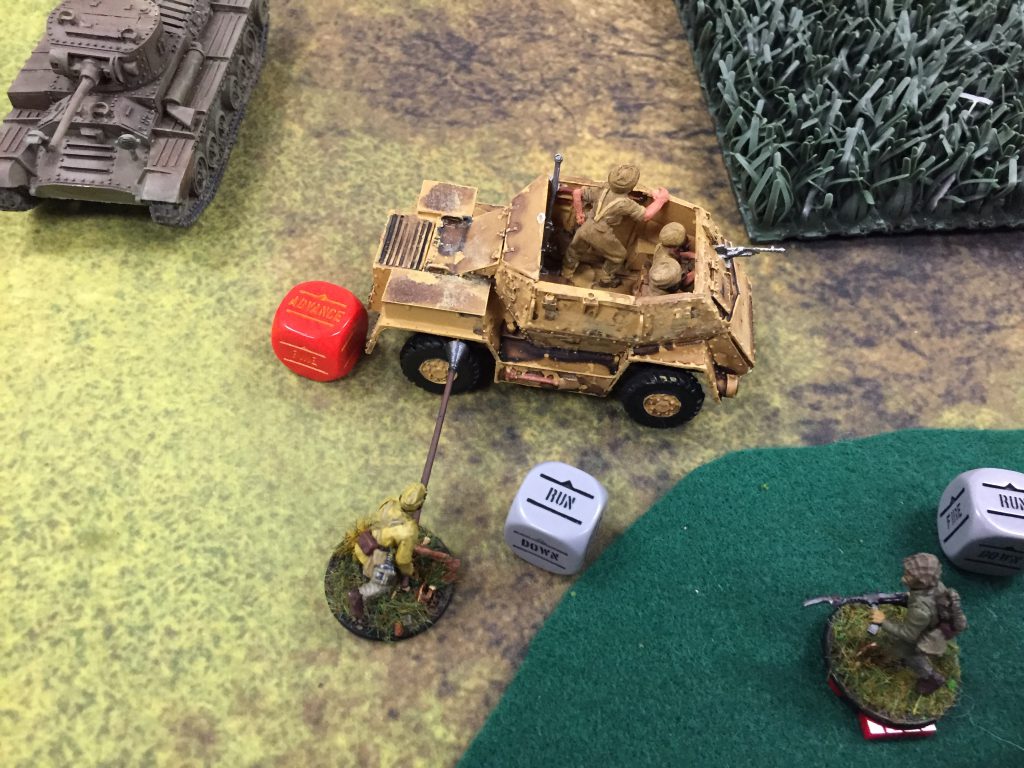
First, if the tank in question was issued a Run order, it cannot be assaulted. Then, the assaulting infantry unit has to pass a morale test at -3 morale (unless they are equipped with anti-tank grenades). Finally, the vehicle gets to react with defensive fire if it has not already acted that turn.
Only then do infantry get to actually try to harm the tank. Hitting a stationary tank is accomplished on a 4+, which a vehicle that has used an Advance order requires a 6+. Each assaulting infantry model rolls one dice to hit. The number of successful hits is tallied up and added to a D6 roll to determine if the enemy vehicle was penetrated.
The upshot of all this is that only large infantry squads with anti-tank grenades really stand much of a chance of harming enemy tanks (except open topped vehicles, which are more vulnerable). As the process is rarely successful, confusing, and a pain in the ass, it is not a popular choice for most players.
The Ignored
These rules are not forgotten, overlooked, or misused. Instead, they are the rules that, through unspoken consensus, the BA community has decided are best just completely ignored. Some are maligned, or considered tiresome/pointless enough that pretending they don’t exist is preferred. Those players impudent enough to insist on using them may find themselves as popular as the student who reminds the teacher to assign homework.

Tiger Fear
Theoretically, this rule gives certain German vehicles the ability to strike fear into the hearts of their enemies with their fearsome appearance alone. In reality, this rule has gone through so many iterations in an attempt to make it work, that many players have just given up on it entirely. It has alternated between overpowered and useless in its many FAQ updates, but has remained consistently annoying to use throughout its development – slowing the game down and really just irritating your opponent more than anything else (something we called out in our Rating the Army Special Rules article). Luckily, Germany’s other special rules are strong enough that players can essentially ignore it, and still be totally viable.
Pretty much any special terrain rules
The Bolt Action campaign books are chock full of special rules for every conceivable type of battlefield environment. Snow, swamps, deserts, and urban environments all have unique rules to bring them to the tabletop. However, no matter how much ink Bolt Action authors continue to spill on this subject, BA players continue to be perfectly content just beebopping right past that section of each campaign book.
To be honest, it’s not hard to understand why these rules are ignored. They often boil down to debuffing units and making large swatches of the map rough terrain, or other effects that generally slow the game down and make it harder to do cool WW2 stuff. As such, they’re not really ideal for pick-up play as you might need to assemble a specific list to address the special rules in play.
I remember one pick-up game I participated in that used snow special rules. Several turns in I realized I couldn’t even reach the objective before the end of the game because I didn’t have the right kinds of transports necessary to traverse the enormous patches of snow terrain. Whoops!
Recrewing artillery
Did you know that if the crew of an artillery piece is wiped out, that you don’t remove the gun from the board, but instead can leave it as an empty gun, able to be recrewed? Well, don’t get too excited, because you can only recrew it using members of another one of your artillery units, and they have to be within 12” to do so – a scenario so unlikely that this rule might as well not exist.
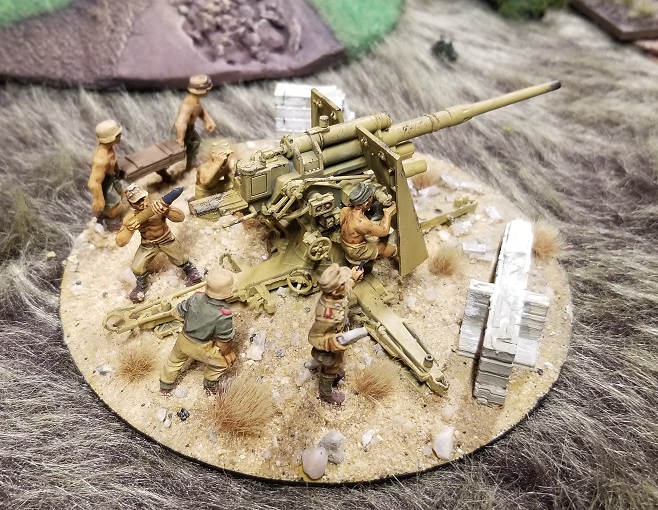
Assaulting with tanks
Earlier we talked about the rules for infantry assaulting tanks, but how about tanks assaulting infantry?! This rule is rarely invoked, I suspect because the obvious solution to pesky enemy infantry is to use the arsenal of guns aboard your fighting vehicle to deal with them. Next time, however, consider just squishing them instead, ala Red Alert!
Interestingly, this basically just forces the enemy to take a Morale Test or face destruction (even fanatics), which means this could potentially be a good tool for eliminating pinned/down enemies that are hard to hit. Having literally never seen this tactic in action, though, it’s hard to say how effective it is. You can also ram enemy vehicles as well, if you’re desperate enough!
Night Fighting
In a forgotten index at the back of the main Bolt Action rulebook, beneath the cobwebs and dust lies a supplementary index on fighting night battles. I suspect the relative unpopularity of this variant is due to the somewhat complicated mechanics of determining who can spot who, which can slow the game down.
This is one part of the rules that I will go to bat for, though. Despite being a little clunky, it is actually pretty fun, because it really changes the nature of the game. Players are forced to think carefully about what orders they give their units, since some activities, like running and shooting, make your unit more visible and could give the enemy an opportunity to spot them.
It also lets units move in closer to each other than they normally would, encouraging assaults and point-blank firefights. There is no requirement that players use night fighting for the entire game either, a favorite game variant of mine is to start the game with a couple turns of “pre-dawn” night fighting that then moves into regular daylight fighting in the second half of the match.
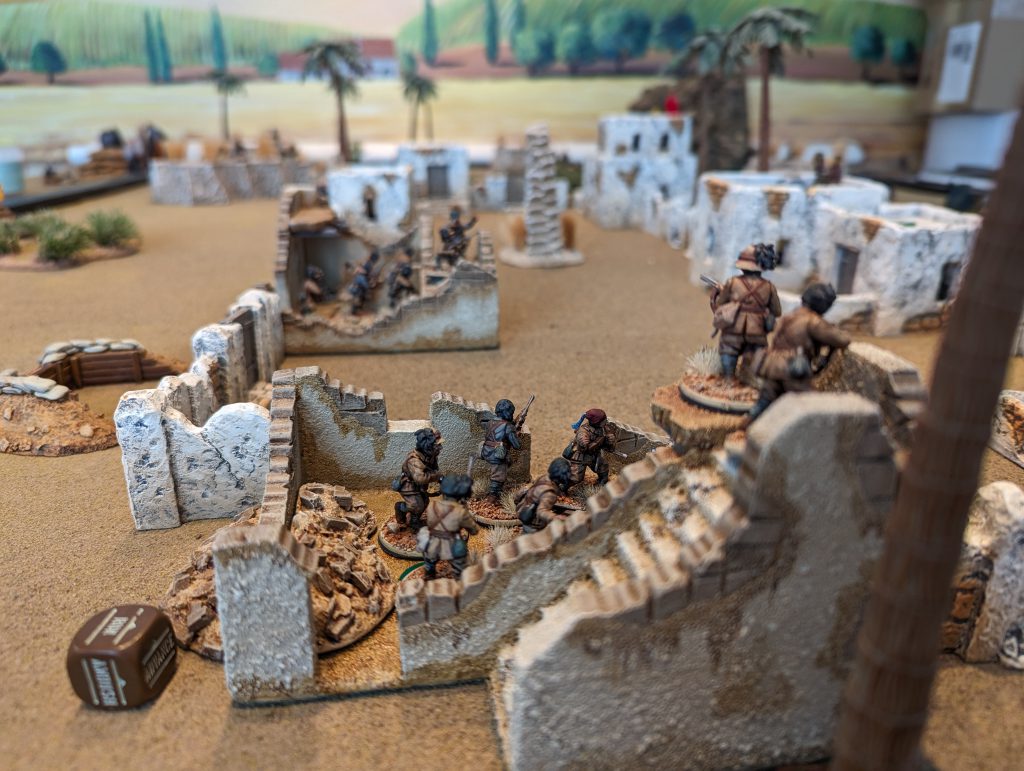
And that’s all folks. Perhaps you learned something from reading this list, such as a rule you were unfamiliar with or unclear about. Or perhaps you were able to shake your head in disbelief throughout the article that so many players could struggle with so many parts of the rules. In any case, thanks for reading.
Let me know in the comments if there is a rule your gaming group struggles with or that you think should have been included in this list!
Questions, comments, suggestions? contact@goonhammer.com, or leave a comment below



You must be logged in to post a comment.